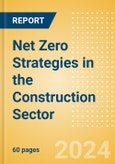The built environment accounts for 39% of global gross annual carbon emissions, with cement and concrete making up 8% and steel making up 9% of the global total. This makes the construction sector and its value chains a prime target for policymakers trying to achieve net zero emissions. Out of the 20 construction majors analyzed in this report, 14 reported Scope 1, 2, and 3 emissions for 2022, up from just two in 2019. Meanwhile, 17 of them have set short-term emission reduction targets, with eight of those approved by the Science-based Targets Initiative (SBTi), a private sector standards body. The main contributors to Scope 1 are direct emissions from on-site fuel combustion, including construction equipment, vehicle fleets, and on-site heating systems Scope 2 ’s main contributors are indirect sources related to purchased electricity. Construction companies are targeting renewable energy, sustainable materials, and the promotion of energy and resource efficiency, waste management, and recycling to reduce Scope 1 and 2 emissions, but must also focus on promoting sustainability within the value chain to achieve meaningful Scope 3 reductions. For Scope 3, these relate to ensuring suppliers adhere to sustainable practices and provide low-carbon products, alongside embedding emissions reductions in materials production and transportation, construction operations, transportation of workers and equipment, and end-of-life demolition and disposal. Tracking end-to-end emissions across complex and lengthy value chains remains a major challenge for construction companies. To reduce emissions, construction companies must be highly selective with suppliers and materials, focus on sustainable partners with sustainable practices and shorten their value chains.
Construction faces significant net zero risk.
- The built environment accounts for 39% of global gross annual carbon emissions, with cement and concrete making up 8% and steel making up 9% of the global total. This makes the construction sector and its value chains a prime target for policy makers trying to achieve net zero emissions.
- Emissions data is improving.
- Out of the 20 construction majors analyzed in this report, 14 reported Scope 1, 2, and 3 emissions for 2022, up from just two in 2019. Meanwhile, 17 of them have set short-term emission reduction targets, with eight of those approved by the Science based Targets Initiative (SBTi), a private sector standards body.
Scope 1 and 2 emissions, which are generated by business operations, make up a small percentage of total construction emissions.
The main contributors to Scope 1 are direct emissions from on site fuel combustion, including construction equipment, vehicle fleets, and on-site heating systems Scope 2 ’s main contributors are indirect sources related to purchased electricity.
Most emissions in the construction sector are value chain emissions, known as Scope 3.
Most of these arise from the production of purchased goods and services, such as cement and steel, and the use of completed projects Scope 3 emissions were reported by 14 of the sample 20 companies for 2022. Companies with large value chain emissions are at risk of higher costs and reduced demand for products as emissions pricing and carbon taxes spread.
Transparency, leadership, and collaboration with suppliers and logistics partners are crucial for significant emissions reductions.
Tracking end-to-end emissions across complex and lengthy value chains remains a major challenge for construction companies. To reduce emissions, construction companies must be highly selective with suppliers and materials, focus on sustainable partners with sustainable practices and shorten their value chains
A minority of construction companies analysed are targeting net zero in all scopes > Most construction companies are focusing on short term actionable targets in their supply chain for Scopes 1 and 2 emissions. Some construction companies are targeting major
CO2 reductions by as early as 2025.
Scope 1 and 2, which are generated by business operations, make up around 15% of total emissions > Most emissions in construction are Scope 3. Construction activities contribute to greenhouse gas emissions through the manufacture of construction products, transportation of materials to construction sites, and the management of construction waste. There is some degree of variety in the ratio of Scope 1 to Scope 2 emissions in the construction sector, with a small minority of companies having a greater percentage share of Scope 2 emissions.
Shifting power sources is one way in which construction companies are cutting Scope 1 and 2 emissions > Sourcing electricity from renewable energy sources for offices one project sites is one of the first things construction companies typically look to do early in the net zero strategy. Deploying strategies targeting sustainable sources of energy, energy efficiency, and the electrification of operations can all potentially reduce emissions significantly
Supply chain collaboration is key to reducing value chain emissions > Managing the construction supply chain is crucial for reducing Scope 3 emissions and involves working closely with suppliers to ensure they adhere to sustainable practices and provide low-carbon products. Companies need to work with downstream industries to jointly develop and implement emission reduction initiatives such as the optimization of transport methods and the use of cleaner sources of energy and energy-efficient technologies.
Scope
The “Net Zero Strategies in the Construction Sector” thematic intelligence report gives you an in-depth insight into the net zero targets and performance of 20 construction companies. The report elucidates the importance of a net zero strategy in the construction sector along with the progress made by the leading companies to achieve the emission target. These detailed analyses are critical in developing effective business plans to gain a competitive edge.
Reasons to Buy
This report -
- Discusses the impact of GHG emissions by construction companies and strategies adopted to mitigate emissions.
- Evaluates various scopes of emissions emanating from the construction industry
- Benchmarks leading companies based on their emissions reduction pathway and net zero commitments.
Table of Contents
- Executive Summary
- Why Construction Companies Need a Net Zero Strategy
- Emissions Targets and Performance
- Scope 1 and 2 Emissions Strategies
- Scope 3 Emissions Strategies
- Net Zero Strategies of Leading Companies
- Glossary
- Further Reading
- Thematic Research Methodology
- Contact the Publisher








